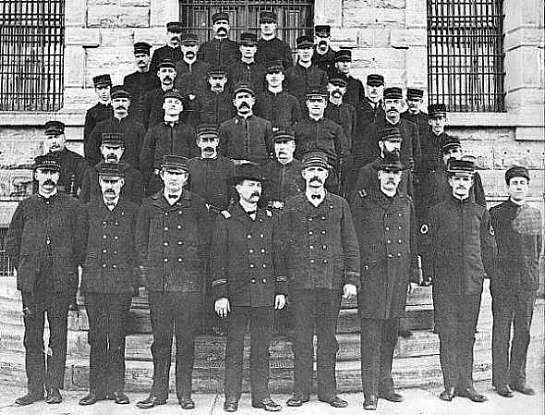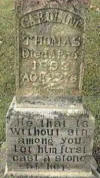 Û
State Penitentiary
Û
State Penitentiary
Anamosa
All photos can be clicked on for larger views.
 Photo:
Lori Vogel. Long
known as the Iowa Men's Reformatory, the facility has recently been
renamed the Anamosa State Penitentiary. Let's hope the inmates are
suitably penitent.
Photo:
Lori Vogel. Long
known as the Iowa Men's Reformatory, the facility has recently been
renamed the Anamosa State Penitentiary. Let's hope the inmates are
suitably penitent.

| The 1915 Index On November 1, 1915, Record Clerk C. L. Peterson released an index of all prisoners and prison employees from the institution's inception (May 13, 1873) through January 1, 1915. Peterson's partner in the indexing project, fellow Clerk S. W. Wetmore, died before its completion. The Index purports to catalog some 8348 names of inmates and staff. Presently, only the staff index is online. The table is available sorted alphabetically by surname and sorted by job title held. There are 881 names in this table. Go to the 1915 Index. NOTE 7/11/24: Original 1915 Index Site now offline; check Steve Wendl's Penitentiary Site |
Anamosa, Jan. 7- Wm. Dilley, Iowa's oldest convict in point of time
served, is dead. He passed away at the Anamosa penitentiary. The
machinery of the old frame simply re-fused to longer carry the load of
affliction. Dilley looked much older than he really was. He was gray and
stooped like an octogenarian. In reality he has spent just half of his
life behind prison bars. Dilley's crime was wife murder and committed at
a time before capital punishment had become a recognized method of
atonement in Iowa. He was doing a life sentence from Johnson county,
where he was convicted in January, 1877. He had served 26 years.
Dilley's number was 239. The highest register number today is 4.967, and
thus has he witnessed the admission and departure by death, parole and
completed sentence of 4,000 men. Dilley has assisted in the construction
of every building that has been erected in the penitentiary in the last
quarter of a century and this means that he has a hand in practically
every piece of architecture that now adorns the state property, for the
walls and all the handsome buildings that now grace the property have
supplanted the former wooden stockade and the temporary structures in
use at the time of his incarceration.
From the Davenport
Daily Republican, Davenport, Iowa, January 8, 1903 and submitted by
Cathy Joynt Labath

Iowa Men's Reformatory staff, 1903. This classic photo was taken at the back steps of the dining hall. First row (l-r): George Walker, George Beaman, A. A. Fife, Harry Smith, Harry Powers, Dr. Samuel Druett, H. H. Kratovil, Wm. D. Thomas 2nd row: Martin McCarty, C. I. Nelson, W. A. Hubbard, John Edwards, Michael Boos, J. Mitchell. 3rd row: J. A. Brummitt, Benbow, C. W. Pulley, H. G. H. Harper, Conner, Oscar Svanberg 4th row: B. G. Rees, C. E. Bauserman, Charles Gould, H. F. Hardt, G. Gwehle, Tip Patterson, George Seeley. 5th row: Graham, J. N. Noel, Lieberknecht, B. F. Morse 6th row: James Taylor, J. H. Lowe, C. D. Stout, Bert Waggoner.

April 6, 1893
Caroline Thomas died at the prison last Thursday at the age of 22
years. She was brought from Des Moines last December for keeping a house
of ill repute and her sentence was for six months. The prison
physician's certificate states that she had a stroke of paralysis
February 16 and another March 31. She was placed in a room fitted up for
her and two of her associates took care of her night and day,
manifesting every kindness possible under the circumstances.
The
burial service was held in the women's department, conducted by Chaplain
Crocker and assisted by Rev. L. U. McKee, of the M. E. church. About a
dozen kind ladies of the city were also in attendance. The women's
apartment was tastefully decorated with flowers, under the guidance of
Mrs. Powers, the matron. The services were very impressive, the lessons
of warning and exhortation being set forth in a most tender yet direct
and forcible manner. Interment was made in the potter's field in
Riverside cemetery, Warden Madden saying that no female convict would be
buried on the farm while he was in charge of the institution.
We
add a word that we would much prefer be not spoken save for the solemn
warning it conveys. The father of Caroline Thomas lives at St. Charles,
in Madison county. He was informed of the sickness of his daughter
before her death. A letter from him dated the 4th says, among other
things, that Caroline would not follow the advice of her parents but
persistently disregarded their wishes. He could not come because too old
and poor, having seven boys in the family.
A further additional
fact we ascertained was that Caroline had been living with a negro in
Des Moines, who has another white woman mistress, and that this negro
was very anxious to have the body of Caroline shipped to Des Moines and
placed in his charge. It seems that a few days ago he shot a man who
visited his place, and the supposition is that he desired to create
public sympathy by providing for the burial of this woman. The father
directed otherwise, however, and the mortal remains of a fearfully
wrecked life, well-nigh consumed by the fires of passion and disease,
were laid away under the sod in a strange, unknown burial ground.
ground.
Caroline Thomas might now have been an adornment in
society as a representative of beautiful young womanhood, but she
rejected the counsels of her parents, willfully sought those paths that
take hold on hell, and after a few brief years—wonderfully brief
years—of ignominy and shame she laid down to die in a prison—where, be
it said, she received the first tokens of real kindness she has known
since she went forth from the home and the ministrations of parents who
sought better things for her. This was a terrible fate for Caroline
Thomas - but is she alone guilty? Does anyone think that the men who
helped drag her down will not have this question to answer in the
judgment?
The photo taken by Steve Hanken in July 2005, shows that Caroline
Thomas' gravestone has been cleaned since the upper photo was taken.
For a selection of other stories involving crime and criminals,
prison breaks and Iowa Men's Reformatory history, go to
Steve Wendl's Web
Page.